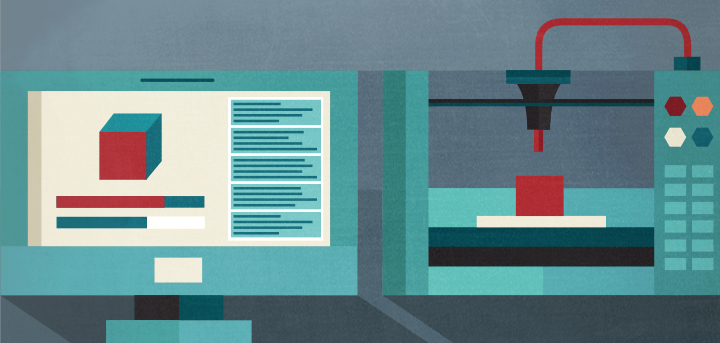
3D Printing for the Modern Crafts Movement
In the 1980s, most tech geeks were still busting their brains over how to develop personal computers and entertainment consoles for the masses. Little did the public know that in addition to the green MS-DOS screens and 8-bit video games entering the market, three decades later developments taking place behind the scenes would revolutionize the worlds of industry, craft, and art.
3D Printing’s Bulky Beginnings
In 1984, a man named Chuck Hull of 3D Systems Corporation invented the basis for 3D printing software. It had the ability for users to design objects on a computer and digitally “slice” them into extremely thin layers. This STL file format allowed special printers to produce three-dimensional objects by depositing sheets of photopolymers, hardened with the help of UV lasers, one pass at a time. Soon, these “additive manufacturing” robots were able to work with metal, and by 1990 plastic feedstock was introduced by Stratasys under the name of fused deposition modeling (FDM). By the mid-1990s, the Z Corporation helped coin the term “3D printing” with its MIT-developed deposition method, which used inkjet printer heads to lay down liquids on powder bases.
Most 3D printing technology remained hidden within the labs of large manufacturing operations for years and out of public use largely due to giant price tags, massive size, and length of time needed to produce an item. It was not until the 2010s that additive manufacturing became more widespread. Due to 3D printers’ increased popularity in the engineering, aerospace, and metalworking industries, the cost of equipment began to drop. Businesses seeking alternatives to injection molding fabrication or looking at new ways to quickly prototype items from architectural models to car parts began to look to 3D printers as efficient, time-saving machines.
Like the room-sized computers that preceded them, many modern 3D printers have shrunk in size and price, becoming more accessible to the everyday hobbyist and entrepreneur. For the true DIYer, open-source projects such as RepRap allow hackers to build their own machines using filament to print in materials such as plastic and metal. Models small enough to fit on a desktop, such as the popular MakerBot, run just several thousand dollars and are ready to use out of the box. While still somewhat expensive for the average consumer, communal Makerspaces and collectives have popped up over the last couple decades to pool funds and share the cost of equipment. Companies that specialize in 3D printing, such as Shapeways, accept files from individuals or small businesses and ship the finished product without the need to buy a printer at all.
How it’s Done: Methods for 3D Printing
Establishing the primary STL file can be challenging for those not familiar with coding or CAD design programs. Luckily, there are generous and talented people who spend their time creating files available for download (for example, with programs like Rhinoceros). Many of these kind souls make their designs open-source and free for public use. 3D scanners, like the MakerBot Digitizer, can turn small, real-world objects into files with the help of lasers that convert hundreds of thousands of reference points into digital information.
Fused Deposition Modeling
One of the many widely used techniques for 3D printing is Fused Deposition Modeling (FDM), which uses plastic or other materials like rubber or clay to add layers that harden the moment they leave the printer nozzle.

Electron Beam Freeform Fabrication
Electron Beam Freeform Fabrication (EBF) takes advantage of metal wire and electron beams in a vacuum environment. Developed by NASA, the technology forms net-like structures from a molten pool of metal that is fed wire and treated with electron beams. NASA hopes this EBF will some day become a viable means to print in zero gravity.

Laminated Object Manufacturing
Laminated Object Manufacturing (LOM) uses layers of adhesive-coated materials including paper and foil. Sheets are added to a substrate with a heated roller and laser-cut to specification. Once waste material is removed, each slice is glued together.

Plaster Printing
Plaster Printing (PP) operates much like an inkjet printer using powder such as gypsum plaster and a liquid binder released from a nozzle to produce layers and then stick them together. This type of printing usually needs some sort of hardener during the finishing phase to add structural integrity.

Stereolithography/ Digital Light Processing
Stereolithography (SLA) and Digital Light Processing (DLP) apply polymers as their feedstock, which later harden once exposed to light.

Direct Metal Laser Sintering/ Selective Laser Sintering/ Electron Beam Melting/ Selective Laser Melting
Direct Metal Laser Sintering (DMLS), Selective Laser Sintering (SLS), Selective Heat Sintering (SHS), Electron Beam Melting (EBM), and Selective Laser Melting (SLM) all use some sort of grain or powder and high-powered lasers to fuse layers together once deposited.

The range of filaments these machines use has expanded from the original thermoplastics to metal alloys, wood, resin, consumables like sugar or chocolate, and even human cells. Most off-the-shelf desktop printers use PLA or ABS filament that is available in a variety of colors. Although many of these plastic-like polymers may not be the most environmentally friendly choices considering their inability to biodegrade, there are companies formulating materials derived from corn, and those that avoid toxic BPA or phthalates. Most filaments arrive in spools of wire with varying diameters and different melting points, so a little research is necessary to find just the right type to accommodate a printer for each project. For a mini-recycling factory at home, diehard repurposers can make a RecycleBot from open-source info or buy a Filabot, which crunches up old plastic milk jugs and bottles and transforms them into filament for projects.
The Third Dimension: The Advantages and Disadvantages to Printing in 3D
Like any human invention, 3D printing technology possesses both positive and negative consequences for the environment and economy. By forming items through an additive process, less material is wasted than when carving whole blocks of virgin stock. When biodegradable or upcycled components are employed as bases, trash becomes art, and surplus crops, including corn or wood pulp, find new lives as industrial textiles. Printing limited runs of items avoids glutting markets with superfluous junk that may linger at the back of stores or end up in landfills. Recreating a broken component from a printed digital file encourages repairing appliances instead of ditching the entire contraption and buying a cheap replacement. Philanthropic organizations such as iLab print essential medical supplies and tools in Haiti and have the potential to bring vital technology to areas previously devoid of necessary manufacturing or delivery infrastructure.
On the financial side of the equation, rapid prototyping cuts down on the time required to build and test models, saving businesses of every size from breaking the bank during research and development phases.
CustomMade artist and jeweler Paul Klecka values the efficiency factor of 3D printing. “I’ve carved thousands of models by hand over the years, but there is zero flexibility to edit the design once carved,” he says. “The digital process allows me to save each file, and I save a project perhaps 30 times during the process. This way I can go back and make adjustments or even rebuild the design elements for another client. The time saved is valued by myself as well as my customer.”

The simple 18K bezel and heavily detailed organic pattern on the ring shank required separate printing, orienting each in different directions. The shank needed careful placement in the 3D build to minimize grow lines in recessed areas
Fellow designer Kyle Squillace of Impressive Prototypes leans on 3D printing technology at the beginning stages of his work. “The printer makes it easier to have a physical, tangible prototype at an early stage rather than at the end when all this time and money has been put into an unproven design that was intangible,” he says. “Bringing the physical prototype into play earlier in the development process will identify shortcomings sooner. Early mistakes are much more manageable than those in the late stages. It may take several iterations of a design before settling on a finished product. Those handmade, labor-intensive prototypes are usually much more costly to cast aside than an item built by the 3D printer.”

The design for these frames was 3D printed in separate components then prepped, primed, and painted before assembling.
The success of makerspaces has been supported in large part by the invention of tools like 3D printers. Even so, most traditional fabricators are unaware of the progress being made in the additive manufacturing world. Consumers can now collaborate with a professional artist instead of going solo for a variety of reasons.
“3D printing is still a new concept to the mass market but we’ve been around it for more than 20 years on the commercial side, so we have the experience and expertise needed for utilizing the printer’s capabilities,” Squillace says. “It also takes a significant investment for most consumer budgets, as well as the time to learn about the materials, process, and post processing. If someone is printing infrequently, it may not make sense to put the investment into a quality machine of their own.”
“In the case of jewelry, my 30 years of bench experience is hugely valuable,” adds Klecka. “If you sat at my desk using my software you might be able to design something—but would it be able to be printed, cast, wearable, and functional? Would the shank, walls, and prongs be the right dimensions? Would the gemstones stay in? Probably not. 3D printing allows me to design things that would be impossible to do by hand.”

Both Klecka and Squillace recognize that while 3D printing is continuing to make headway, the technology still has a long way to go, particularly in the arena of feedstock material for high-end work.
“Print speed, material offering—metals in particular, ease of use, and cost are all areas in the field that are being improved and developed further due to feedback from customers,” Squillace says. “All of these will need to be greatly improved to truly make the 3D printer a mass market product like the inkjet printer has been for many years,” he says.
However, just because it is possible to print a fancy paperweight or personalized knickknack does not mean it’s necessary. 3D printers have the potential to shift the center of production to individuals and there is no guarantee every artist or tinkerer will follow the ethos of sustainability. The temptation to spit out millions of objects can be overwhelming. As Klecka observes: “How could you not love a machine that turns your digital dreams into reality!”
Even those who favor downloading over designing could get carried away with printing garages and closets full of what they want, without regard to where their newly-minted creations end up once they lose their luster. Consumers and artists alike must remain aware that although the shape and length of the supply chain changes with the addition of a 3D printer, the finished product will always need to find a final resting place—be it returning safely to the earth in the form of biodegradable polymers or sticking around forever as a petroleum-derived plastic.
As printers and their components become more mainstream and newer, flashier models hit the market, they face the same disposability perils as electronic mobile devices and appliances. Yet as long as the additive manufacturing movement keeps the environment in mind, it is exciting to see what the future holds for a machine that can bring anything from human organs to entire houses into existence with the speed, accuracy, and precision of a robot.

